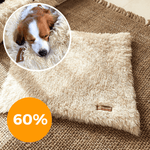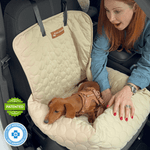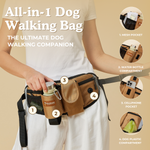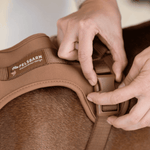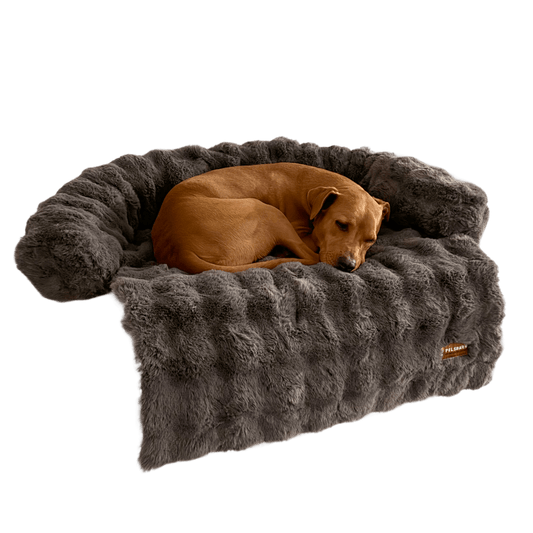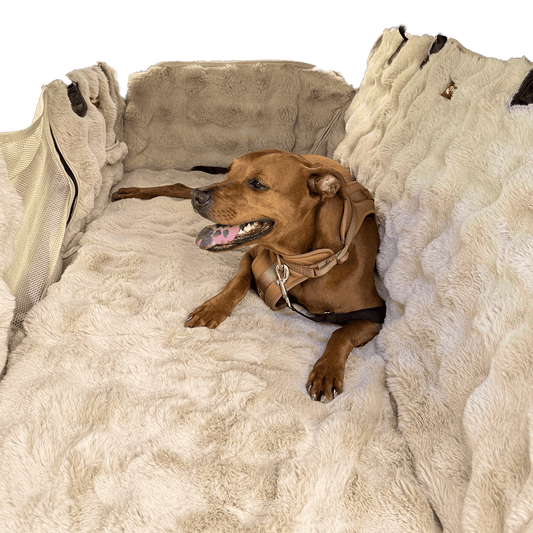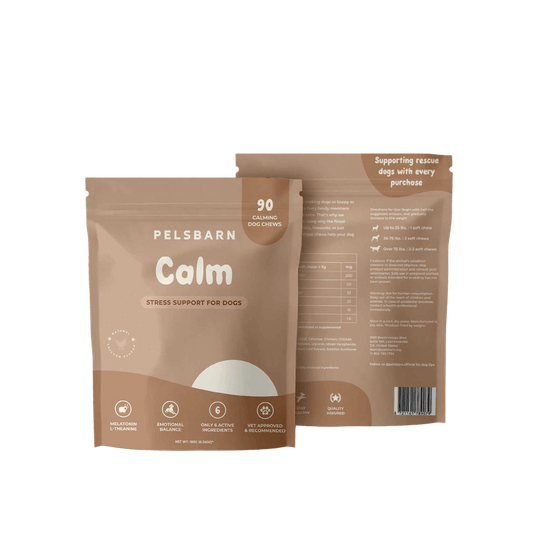Dogs often look cosy and warm due to their fur, and it is an easy assumption that they don´t get (as) cold as we do during the colder months of the year. Sadly, our beloved furry friends do experience the chill of colder seasons as well.
This guide explains when dogs get cold, the ideal temperature range, and simple ways to keep them cozy and happy through cold, rainy autumn days.

Do Dogs Really Get Cold in Fall and Winter?
Yes. Even though dogs have fur, not all are equally protected.
Dogs are endotherms (warm-blooded), so they generate internal heat and regulate body temperature. But their ability to maintain comfort under varying temperatures is limited by physiology (coat, body size, metabolic rate, etc.). So your dog’s body does try to adjust, but that doesn’t mean they are always perfectly comfortable.
Smaller breeds, senior dogs, and those with short or thin coats lose body heat faster and are more sensitive to cold temperatures. Puppies, too, are still developing their ability to regulate body temperature, which makes them more vulnerable in chilly weather.
Double-coated breeds like Huskies or Golden Retrievers can tolerate lower temperatures better, but that doesn’t mean they enjoy lying on cold floors or walking in icy rain. A good rule of thumb: if you’re reaching for a winter jacket, your dog might appreciate an extra layer too.
It’s also important to remember that dogs are much closer to the ground than we are. Cold air settles low, and frosty surfaces can affect them more quickly. In freezing conditions, hard or icy ground can even damage the sensitive paw pads, since dogs don’t have the protection of shoes. Regular paw care and using a protective balm can help prevent cracks or irritation.
What’s the Ideal Room Temperature for Dogs?
There is no universal “cold threshold” (one temperature number) below which all dogs feel uncomfortable. As this depends on so many variables such as breed, acclimation, health etc. For this reason it is important to always keep an eye out for signs your dog might be uncomfortable in cold temperatures. Having that said, most dogs usually feel comfortable indoors between 65–72°F (18–22°C). Roughly the same as humans.
-
Below 50°F (10°C): short-haired or small dogs will likely start to feel cold.
-
Below 0°C (32°F): limit outdoor time even for large breeds.
Watch for signs your dog is cold:
-
Shivering or trembling
-
Curling up tightly or seeking blankets
-
Cold ears, nose, or paws
-
Moving slowly or refusing to go outside
👉 If you notice any of these, warm your dog up gradually and offer a cozy resting spot.
How to Keep Your Dog Warm at Home
Even in a heated home, hard floors and drafts can make resting spots chilly.
Here’s how to help your pup stay snug and relaxed:
1. Choose a Warm, Supportive Bed
A well-insulated bed keeps your dog off cold tiles or hardwood floors, helping them maintain body warmth while they rest. If your dog’s bed sits directly on the floor, make sure it has enough padding and insulation to prevent heat loss through the surface.
The Pelsbarn Orthopedic Bed is a great example: its thick, supportive foam and raised design keep your dog comfortable and protected from the cold below.
If you prefer keeping your dog close by on the sofa, the Luxurious Sofa Bed offers the same plush comfort with added height from chilly floors.
Both options provide a warm, cozy retreat. Especially during long, cold nights.
2. Add Layers for Comfort
Use a soft, warm blanket to retain warmth. Giving your dog the option for more or less heat as they need during the night. Some smaller or short haired breeds might even be better off wearing a coat when going outside.
3. Avoid Drafts
Place beds away from windows, doors, or air vents.
If your home has tile or stone floors, add a rug underneath the bed for insulation.
4. Dry After Walks
Always towel your dog off after being outside. Damp fur cools the body fast, especially in windy or humid weather.
Fun Things to Do With Your Dog When the Weather is Too Bad to Go Outside
Cold, Rainy or snowy days can still be full of joy and bonding time. Try these cozy indoor ideas:
|
Activity |
Why It’s Great |
|
Hide-and-Seek with Treats |
Stimulates your dog’s sense of smell and keeps them mentally active. It is like a Fall Dog Easter Egg Hunt. |
|
Puzzle Toys or Slow Feeders |
Turns mealtime into a fun challenge. |
|
Indoor Fetch (soft toys) |
Keeps energy levels balanced, especially for high-energy breeds. |
|
Training Mini-Sessions |
Practice recall, “stay,” or “roll over.” Short bursts = focus and fun. |
|
Cuddle Movie Time |
Strengthens your bond: dogs love shared rest time. |
💡 Pro tip: combine playtime with short sniff walks when the weather eases up. Even five minutes outdoors helps release energy.
Outdoor Tips for Chilly, Wet Weather
If your dog loves outdoor adventures, here’s how to make them safer:
-
Dress for the weather: A water-resistant coat or even a sweater keeps your pup warm.
-
Protect paws: Use paw balm or booties against cold, wet pavement or road salt.
-
Short, frequent walks: Better than one long, damp one.
-
Always dry off afterwards: Especially between paw pads to prevent irritation.
When to Worry About Cold
Call your vet if your dog shows any of these symptoms after exposure to cold:
-
Persistent shivering
-
Pale gums
-
Lethargy or stiffness
-
Whining or anxious behavior
These can be early signs of hypothermia, particularly in small or senior dogs. Although these are more likely to occur in winter rather than fall, it is good to keep an eye out for them when temperatures are low.

FAQs: Keeping Dogs Warm in Fall
Do dogs need blankets in the house?
Yes, especially short-haired, small, or senior dogs. A blanket helps regulate warmth and adds comfort.
What temperature is too cold for dogs to sleep in?
Below 10°C (50°F) is too chilly for most dogs indoors without extra warmth. Always watch for signs of discomfort.
How can I exercise my dog when it’s raining?
Try indoor games, puzzle feeders, or short play sessions inside. If you go outdoors, keep walks brief and dry your dog afterwards.
Final Thought
Fall is the season of cosiness and cuddles. And of course your dog deserves just as much comfort as you do. With the right bed, blanket, care and knowledge you’ll keep them warm, relaxed, and happy all season long.
I hope this helps, and wish you and your dog a wonderful cosy season.
Warmly,
Elle from team Pelsbarn.
